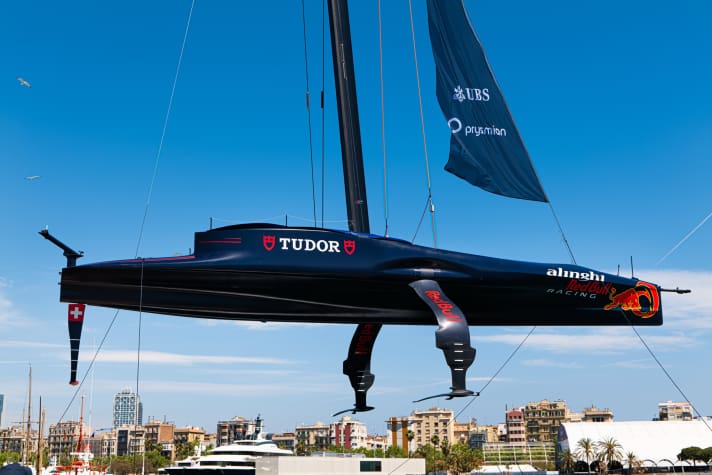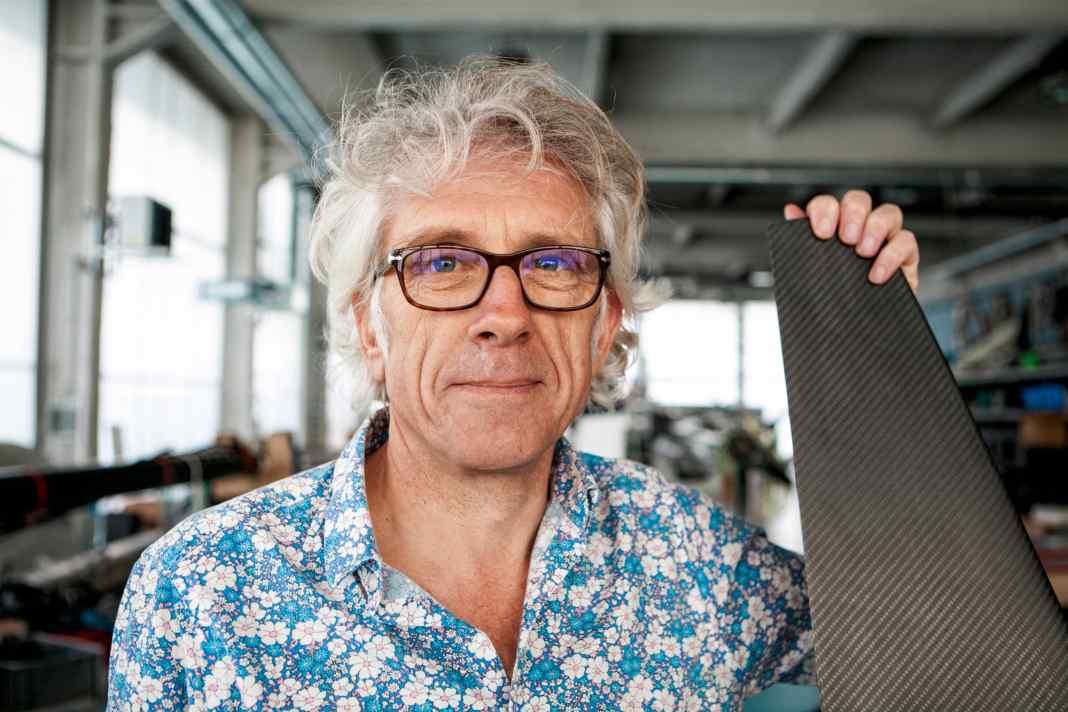





YACHT: The challengers' designs seem to be on a par, at least at times. So how decisive will the performance of the sailors be at the 37th America's Cup be?
Dr Martin Fischer: Sailing performance will certainly play a major role. Especially because there are of course significantly more waves in Barcelona than we had in Auckland. The probability of making a mistake, either when manoeuvring or even when sailing straight ahead, is significantly greater due to the waves.
What are the special challenges of the precinct, and what adjustments did the change of precinct entail?
The waves are simply much higher. In Barcelona, there will probably be races with a wave height of one metre or maybe even more. These are conditions that we've never had in New Zealand. And even with half a metre it's difficult to sail these boats. Manoeuvring a boat that is over 40 or 50 knots through waves is not that easy. And that's why all the teams naturally had to look at how to make the boats more tolerant.
For example, the foils must not lose all of their buoyancy as soon as they penetrate the surface. Ventilation is a major challenge and we had to think about how to make foils that are tolerant of ventilation.
On the fuselage, all have a bustle (Shaping of the fuselage on the underside, editor's note.), which supports the end plate effect, but slows down as little as possible when the lower part touches the water. This is why it is cut very sharply in the lower section of all of them, so that you don't create much resistance when this part hits the water.
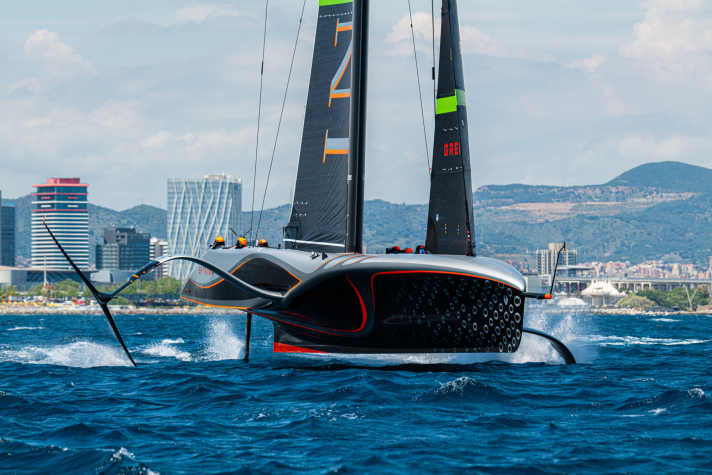
The volume in the bustle is not only useful for dipping, but also helps with lifting ...
Exactly. There is a trade-off between the resistance during take-off, i.e. when the hull is still in the water, and the efficiency when the boat is flying. When the boat is flying, you would prefer to just have a plate. A vertical plate that prevents pressure equalisation. But of course that would be pretty bad when taking off. The wetted surface would be enormous and the boat would not take off in light winds. So you have to find the right compromise between the risk of failure during take-off and efficiency when the boat flies.
When will the latest generation AC75s take off?
There will be no sailing below 6.5 knots. I assume that all teams have designed their boats so that they can take off in 6.5 knots of wind. You could also tow the boat before the start to get it flying, but with little wind there is always the risk that you will mess up a manoeuvre at some point and then have to take off again. Or that there is a brief wind hole. It would be a high risk to ignore this.
All designs for the 37th America's Cup in detail:
- First Cupper unveiled - Alinghi comeback complete
- Defender unveils new yacht - competitors shocked?
- Italy's Cup pride and joy christened - "Luna Rossa" arrives as a Silver Arrow
- The British unveil "RB3" - are all good things come in threes?
- Silver can soon back in America? - "B3" from American Magic unveiled
- "We are dreamers, we are doers" - France's "Orient Express" christened
How did the new set of rules come about, was it to make the boats faster or was it simply a different design challenge compared to Auckland?
After the last Cup, we, Team New Zealand as the defender and Ineos Britannia as the first challenger, thought about how we could or should change the rules to make the races more interesting. And one of the weak points in Auckland was clearly that the boats had difficulty taking off in very light winds. To improve the light wind lift-off characteristics, the wingspan of the foils was increased to 4.50 metres, among other things. As a result, the so-called induced drag is reduced by around 20 to 25 per cent. That is a considerable gain.
Have there been any further adjustments to the regulations?
Yes, the boat has also become lighter. Firstly, we have less ballast in the foils, and then the crew has also been reduced from eleven to eight sailors. This results in a total weight reduction of almost one tonne. But it also means that we have fewer people generating energy. That's why cyclists were allowed.
In addition, a self-tacking jib has been authorised and the backstays have been removed. Both are measures to reduce energy consumption, especially during manoeuvres, in order to be able to sail the boat with eight people at all.
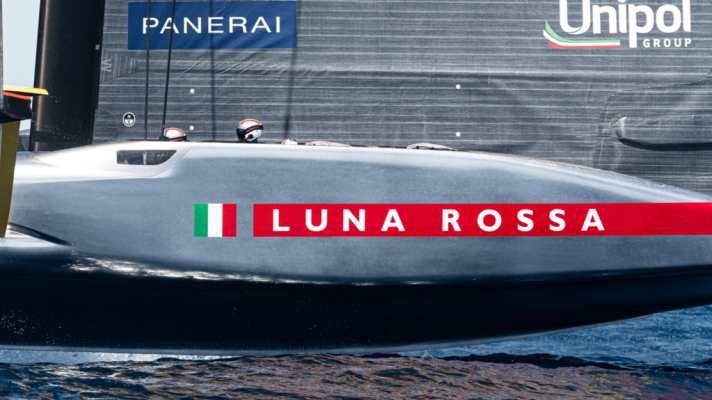
What effect does the elimination of the backstays have on the rig?
At Luna Rossa we had already tried to sail without backstays on the AC36, but this was then forbidden. So the rig from last time was able to cope with it, so nothing had to be changed. The only thing that has been made mandatory in the rules is the addition of some reinforcements in the mast. The loads on the shrouds naturally increase when the back stays are removed, which is why the points where the shrouds are attached to the mast have been reinforced. But in principle, you can still sail in this America's Cup with a mast from the last America's Cup.
One interesting area of the rule changes relates to the coupling of functions on board. What is this all about?
You can measure all sorts of things on the boat. However, it is forbidden to feed measurements that describe the condition of the yacht - speed, wind speed, heeling, whatever - into the boat's control system. However, it is permitted to show these values on a display. But only with a delay of two seconds. Last time it was one second, this time it's two.
This was introduced to prevent the teams from installing a system like the one the New Zealanders had in Bermuda. They had an autopilot that calculated how the foils had to be set at all times. And they declared this as a display. In other words, it was displayed on a touchscreen and the person controlling the foils simply followed a dot with their finger. If the display can only show the data two seconds later, that's too late. This is how such systems were prevented.
What has changed, apart from the difference of one second, is that other variables can be built into control systems. For example, you can measure the mainsheet tension and have a control that allows the sailor to say: "I want five tonnes of mainsheet tension now". And then the system sets five tonnes. That is allowed. That wasn't the case last time. And you can also make couplings. When I hoist the mainsheet traveller, I usually also want to hoist the jib traveller. You can now couple the two so that they always move simultaneously without any time delay. For example, you could also combine the rudder angle with the traveller. Many things are allowed, but not everything.
How does the design process work at the America's Cup?
You can't develop the whole boat at once. This means that the boat is divided into different areas, i.e. foils, rudder, sails, hull and so on. Then you start to develop the individual components based on certain assumptions. However, this very quickly results in an iteration. The shape of the hull naturally influences the shape of the foil, which in turn influences the sails and so on. This means that everything has to be coupled, but you can't optimise it all at once. And that's why this is usually done via an iteration.
A general example of optimisation problems: We want to optimise a part that has 100 free parameters. Then it is much more difficult to perform this optimisation with 100 free parameters than two separate optimisations with 50 parameters, each with 50. This is much easier. Or ten different optimisations with ten parameters.
We therefore divide the optimisation problem into different areas and then optimise each area. In order to achieve the coupling between these areas, i.e. to optimise the overall system again, the whole thing is done in an iteration. In other words, you go through an initial loop in which you optimise the hull, foils and so on under certain assumptions. Then you throw everything together and see how it works, and these results then provide the modified assumptions for the next design loop, and so it goes on.
What role did the smaller Leq12 test boats play in the process?
They were extremely helpful for testing certain hypotheses. The waves in Barcelona were new territory for everyone. And we didn't really realise how difficult it is to sail a boat like this in such conditions. The Leq12 boats played a major role. Tests were carried out with the foils and the control systems under the conditions in Barcelona. This then fed into the design process for the actual racing boat.
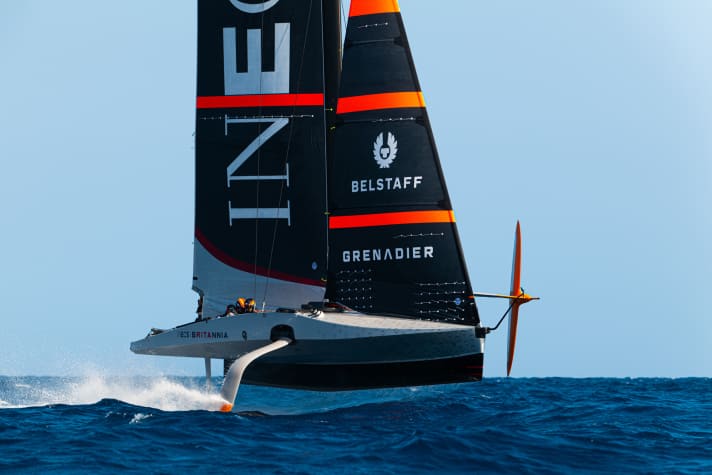
Can foils, for example, be scaled up 1:1 to a large boat?
This is not universally valid, but it is possible within certain limits.
Then the AC75s of the previous generation could have been very helpful ...
The old AC75 is very helpful and you can learn a lot from it. However, the rules were now such that you were not allowed to test new components on the old boats. For example, it was not allowed to screw new foils onto the old boats. This would probably have given the New Zealanders a huge advantage because their boat from the last Cup was clearly superior to the other boats. However, a few things are allowed, for example in the area of hydraulic systems or deck layouts. These could be changed and then tested on the old boats. And some teams, such as the Swiss, also did this. The same goes for the New Zealanders and the Americans.
How much have you learnt about the developments of others and do you incorporate them into your own design?
So at the very beginning, of course, you have no information at all about what the others are doing. We only got information when the first Leq12s were on the water. Of course, you could already see the direction in which the teams were pushing development. But that was relatively late, by then we were all pretty far along with our designs. However, it wasn't too late to change anything. What we already knew then and what has now been confirmed was that all the teams had gone in roughly the same direction with the foils, for example.
Everyone seems to agree on that. The hulls are a different story. At Leq12 you couldn't see much in the way of hulls. On the one hand, because some teams had the AC40 as a test platform. Two teams built their own Leq12, that was us and the Italians. But you couldn't see much there either, because it was primarily about having a platform for the tests. And at least from my point of view, I also have great doubts that you can simply scale up the aerodynamics of such a boat, for example. That doesn't really work.
In terms of foils, it seems that all teams have a relatively flat, flared blade with upturned fixed tips at the foil tips. The bulbs in the centre are also very similar. What makes this shape so good?
That's right, we all have it very similar. There are various reasons why the foil sits behind the arm. Firstly, we try to keep the distance between the foil and the centre of gravity of the boat as small as possible. It also seems to be the case that a foil has less resistance when it sits behind the arm.
If you look at the outline of the foils, they are all more or less triangular. The strength defines that. If you were to make a purely elliptical foil, it would simply be too difficult in terms of strength. The bending moment at the root of the foil would be too great and you would need very thick foils, which would create a lot of resistance. The relatively triangular shape is therefore largely determined by the strength.
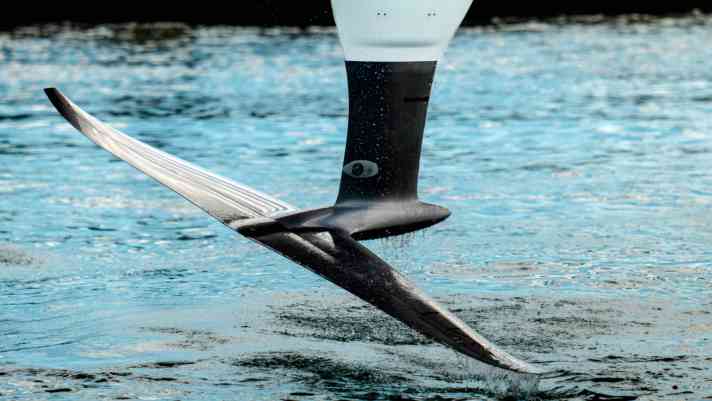
The foils are less angled downwards this time ...
Yes, there are various reasons for this. A distinction is made between T-foils and a foil with the foil tips pointing downwards. If the foil pierces the surface of the water, the angle with the T-foil is much more favourable than with the angle to the foils. And since there are waves in Barcelona, everyone went in the direction of the T-Foil.
At the helm, the foil lifts slightly in the centre for all teams. This is a little more extreme for you, what effect does this have?
We call this the seagull shape, i.e. like the wings of a seagull that rise up in the centre. This is primarily to prevent cavitation at the interface between the rudder and the wing. If you simply butt vertical and horizontal together, then you have negative pressure peaks in that area, and that leads to cavitation and drag.
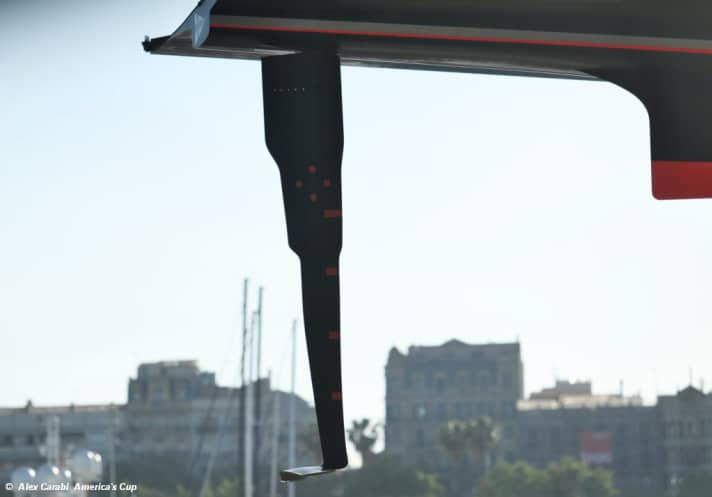
You are only allowed to build a three-piece set of foils, i.e. two foils with one as a spare. To what extent can modifications be made before the Cup?
You can still do a lot. We are only allowed to use three foils in total, and they have to have the same design. Modifications must be such that 80 per cent of the mass, i.e. the weight, remains untouched. Conversely, this means that you can modify 20 per cent. If you realise that something somewhere is not as you had imagined, you can do something about it. But you can't rebuild the old foil so that 80 per cent of the mass is identical. That's not allowed, it has to be the original. This also applies to the rudder.
To what extent can you customise the foil arms or at least their cladding?
There's not much you can do about them. The foil arms are so-called supplied components. This means that all teams have to buy them from the same manufacturer and the structural part is completely identical. The same applies to the leading edge. The teams can build the trailing edge themselves, but the shape is prescribed. But the one-design foil arm ends at a certain point, but not at the bottom. The last vertical part counts as part of the foil in the measurement. So you can do what you want there.
Emirates Team New Zealand has developed a new mainsheet system to control the two sail skins individually. What are the advantages of this and could this system potentially become decisive?
We had also looked at this, but came to the conclusion that there wasn't much in it. There are advantages and disadvantages to this system. The advantages are primarily that the point of attack of the sheet on the sail is further down. We believe we have found another solution that is lighter overall and has less friction.
Doesn't it make much difference to the trim?
I hope not. It's always possible that we're wrong. But we haven't seen any great advantage.
In general, all teams seem to have shifted the crew weight as far forward as possible - Why?
Bringing the centre of gravity forward has the advantage of generating more righting moment. If the centre of gravity is very far back, the rudder pushes upwards. The more the rudder pushes upwards, the more you lose righting momentum.
There is a theory that your rudder even pulls downwards ...
Yes, this is also the case with all boats. From a certain speed, they all pull downwards. You can easily see that. With the AC40s, for example, you can see that if a manoeuvre goes wrong and the elevator of the rudder comes out of the water, the boat plunges forwards. This shows that the rudder has pulled downwards in this case.
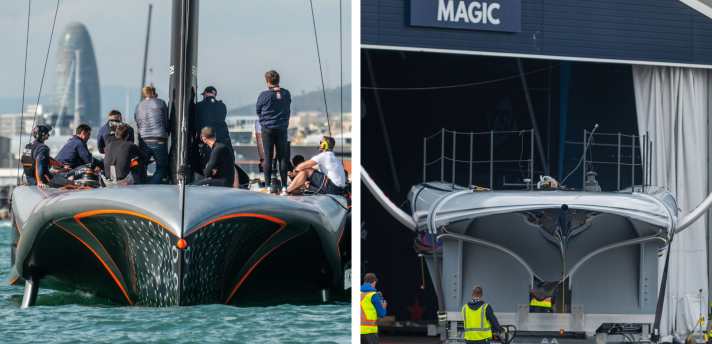
Your boat and that of American Magic are very far apart in terms of volume - especially in the bustle. How do you achieve such different results in the same area?
The Americans have obviously designed everything to minimise aerodynamic resistance. Hence the cyclists who do not sit but lie down. This enabled them to lower the sidepods. They probably have the smallest contact surface when you look at the boat from the front. There are different opinions as to whether this is right or not. We've obviously gone down a slightly different route.
The helmsman and trimmer sit next to each other on the Americans. How great is the aerodynamic disadvantage, and how great is the advantage in terms of the centre of gravity?
I also assume that the aim was to get the centre of gravity forward and also to give the sailors a better view. I'm not sure whether the gain they probably have in that direction can compensate for the aerodynamic disadvantage.
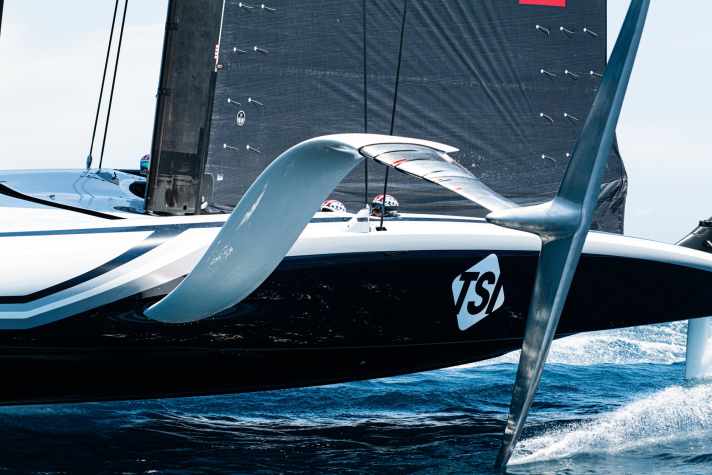
Alinghi has also gone its own way in one respect in particular and has radically cut off the crew's sidepods; the deck behind them is completely flat. Optics or revolutionary?
I don't think it's optical. I think they've thought about it carefully. We're looking at it to understand exactly what the background is. Also to understand where the weaknesses and strengths of this approach are. We have our ideas about it, but I can't say too much about that right now. Our AC75 shows what we think is the best solution. We assume that Alinghi's solution is not the best. But we won't know for sure until we sail against each other.
